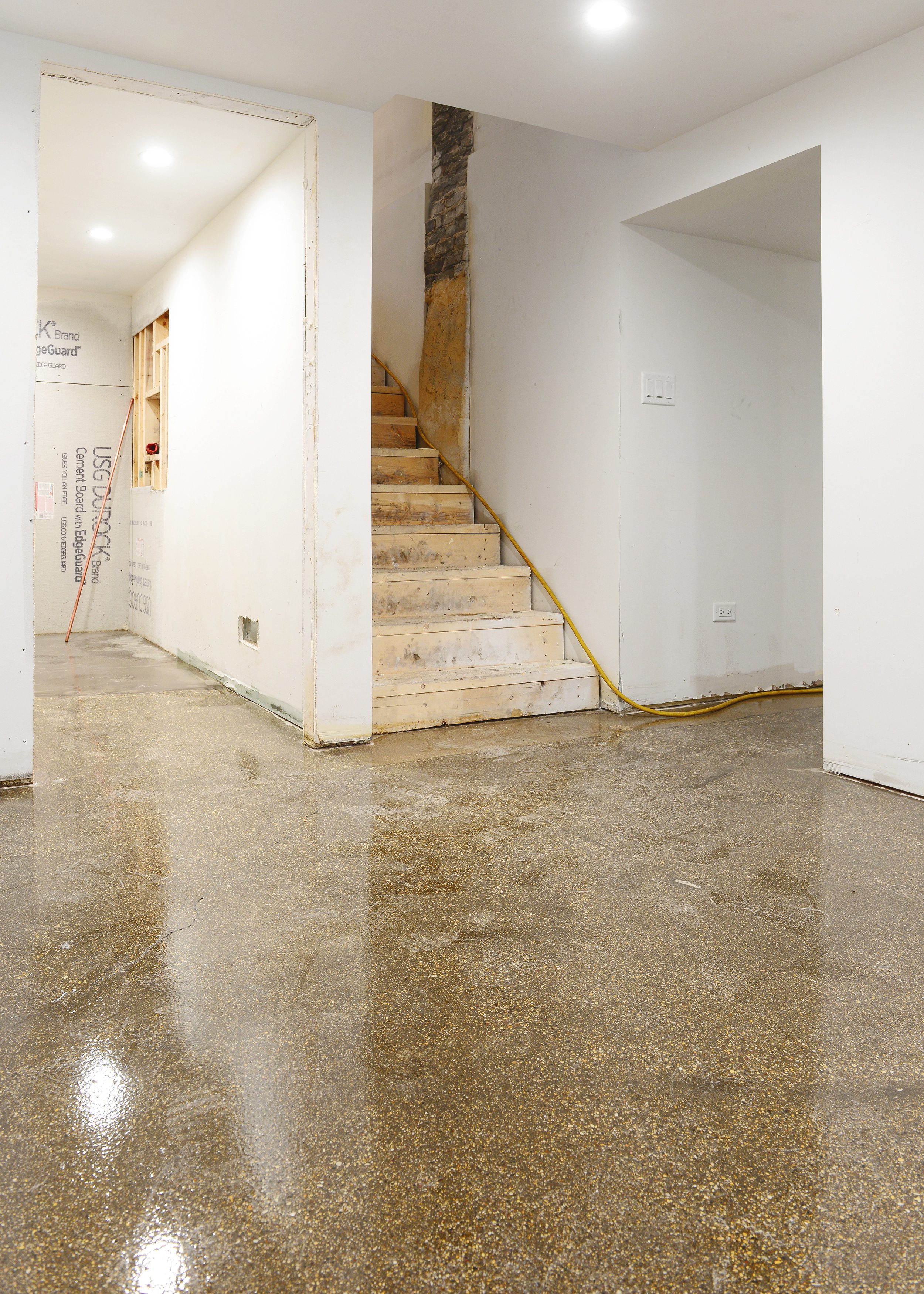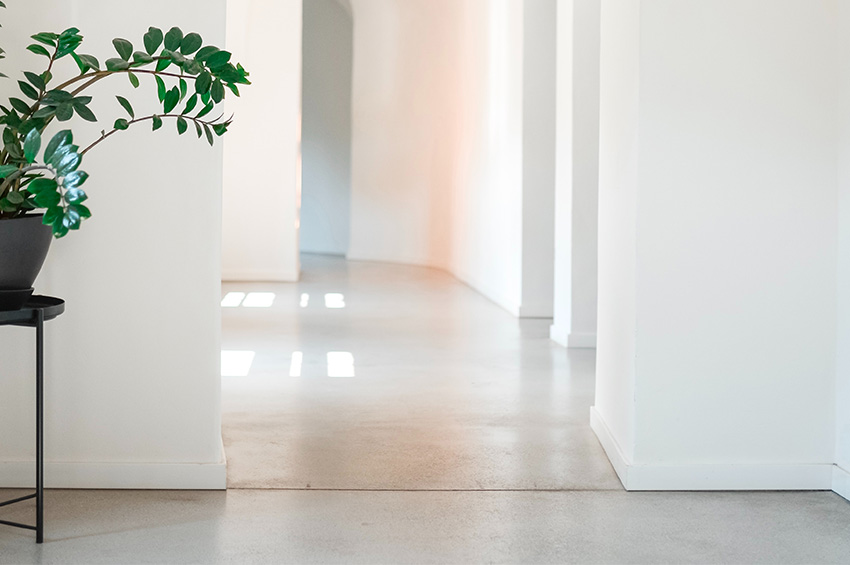Comprehensive Guide to the Services Offered in Polished Concrete Floor Covering Installation
Polished concrete flooring installment includes numerous vital services that add to a sturdy and aesthetically appealing coating. The process begins with precise surface area preparation, making certain the concrete slab is tidy and complimentary of blemishes. Following this, grinding and sharpening techniques are employed to attain a smooth surface. The trip does not finish there. Comprehending the different choices for tinting, securing, and upkeep can significantly impact the last outcome and durability of the flooring.
Surface Preparation Strategies
Before setting up polished concrete flooring, appropriate surface preparation is critical to assure a sturdy and visually pleasing finish. This initial stage involves a number of vital actions that validate the substratum is ideal for the overlay. First, any kind of existing flooring, such as rug or floor tile, need to be removed to subject the concrete piece. Next off, the surface area needs to be completely cleaned to eliminate dust, grease, and various other contaminants that could hinder adhesion
In addition, assessing the condition of the concrete is necessary; fractures, imperfections, and surface area abnormalities have to be resolved. This may consist of patching or progressing to develop a consistent base. Dampness testing is likewise advised, as excess moisture can lead to future difficulties. Applying a primer can boost attachment between the concrete and the brightened surface. By complying with these surface prep work techniques, the long life and look of the polished concrete flooring are significantly enhanced.
Grinding and Sharpening Procedures
When the surface area preparation is full, the grinding and developing processes play a vital role in achieving a top quality polished concrete finish. Grinding includes the use of specialized diamond-embedded devices to get rid of any kind of surface area blemishes and accomplish a degree surface area. This process is vital for exposing the concrete aggregate, which adds to the floor's visual charm.
Refining complies with grinding and includes finer rubies to develop a smoother surface. This stage enhances the concrete's appearance and prepares it for subsequent sprucing up. The grit degrees utilized during sharpening are carefully selected to guarantee a polished coating without endangering the stability of the concrete.
Both grinding and honing call for knowledgeable drivers who understand the nuances of the concrete surface and can readjust techniques according to specific project requirements. Proper implementation of these procedures significantly affects the sturdiness and aesthetic quality of the final polished concrete flooring.
Brightening Methods and Tools
A number of reliable polishing techniques and specific devices are utilized to attain a high-gloss finish on concrete floors. The most common method entails utilizing diamond sprucing up pads, which are available in differing grits. These pads are mounted on floor brightening machines that methodically grind the surface area to the desired sheen.
Wet brightening is preferred for its capability to reduce dirt and decrease warm, while completely dry polishing is preferred for its efficiency in smaller sized spaces. Additionally, worldly flooring grinders are typically utilized as they provide even pressure and speed, ensuring consistent outcomes.
Advanced tools might include automatic or remote-controlled makers, which enhance productivity and lower labor intensity. Ultimately, choosing the appropriate polishing technique and tools is crucial for attaining the preferred surface and resilience of the polished concrete flooring, satisfying both visual preferences and functional needs.
Tinting and Staining Choices

Tarnishing Strategies Summary
Exploring different staining strategies can noticeably enhance the visual appeal of polished concrete flooring. Tarnishing alternatives fall under two primary classifications: acid-based and water-based discolorations. Acid stains react chemically with the concrete, producing rich, variegated colors that mimic all-natural rock. They penetrate deeply, leading to a long lasting finish. On the other hand, water-based spots offer a broader spectrum of colors and are much easier to use, giving an extra consistent appearance. In addition, concrete dyes can accomplish dynamic tones and are commonly used together with spots for included deepness. Each method can significantly modify the visual characteristics of the surface, permitting modification that satisfies specific layout choices while guaranteeing an unique, sophisticated search in any area.
Shade Options Available
A diverse combination of color alternatives is readily available for improving polished concrete flooring via staining and dyeing techniques. These techniques enable a variety of hues, from natural tones to dynamic tones, providing home owners and services the adaptability to match their visual choices. Acid-based discolorations respond chemically with the concrete, producing a variegated look that simulates all-natural rock. On the other hand, water-based discolorations give an extra consistent shade and are readily available in a bigger variety of colors - Polished Concrete Floors Austin. Dyes can additionally be made use of to accomplish strong, brilliant shades, enabling complex designs and patterns. Each alternative contributes to the overall effect and durability of the floor covering, making color choice a crucial consideration in polished concrete setup
Personalization and Results
While thinking about polished concrete flooring, personalization alternatives for tinting and tarnishing play a necessary function in attaining one-of-a-kind aesthetics. Home owners and services can pick from a varied combination of colors, enabling customized styles that suit their particular tastes and atmospheres. Staining techniques, consisting of acid and water-based alternatives, enhance the natural appeal of concrete while giving a sturdy coating. Acid spots produce abundant, variegated shades, while water-based stains supply a more comprehensive variety of colors and are a lot more eco pleasant. Additionally, ornamental impacts such as metal coatings or shade overlays can include deepness and aesthetic interest. This degree of Austin Polished Concrete customization guarantees that brightened concrete flooring not only meets functional needs however also complements the total style vision of the space.
Securing and Shielding the Surface area
Securing polished concrete is vital for improving durability and stopping damages from spots and wetness. Numerous kinds of sealants are readily available, each offering special benefits and defense levels. Comprehending these choices is important for keeping the honesty and look of the flooring.
Relevance of Sealing
The durability and visual allure of polished concrete flooring greatly rely on the application of a top quality sealer - Polished Concrete Austin Tx. Securing serves several purposes, largely protecting the surface area from spots, moisture, and abrasion. By creating an obstacle, sealers stop the penetration of fluids and chemicals, which can trigger discoloration and destruction with time. This protective layer also enhances the sparkle and visual depth of the concrete, adding to its total elegance. In addition, proper sealing lowers upkeep requirements, making it easier to cleanse and maintain the flooring's look. Regularly sealed concrete floors show enhanced durability, guaranteeing they hold up against hefty foot web traffic and stand up to wear. Inevitably, sealing is a vital action that markedly impacts the efficiency and life-span of polished concrete flooring
Kinds of Sealers
Selecting the right kind of sealant is crucial for preserving the integrity and appearance of polished concrete flooring. There are mainly two categories of sealants: passing through sealants and topical sealants. Penetrating sealants, often silicone or silane-based, penetrate the concrete, supplying protection versus dampness and discolorations while allowing the surface area to breathe. On the other hand, topical sealers, Check This Out such as acrylic or epoxy, develop a protective film externally, improving gloss and shade while supplying a barrier versus wear and chemicals. Each type has its advantages; passing through sealants are ideal for high-traffic locations, while topical sealants offer a more visual surface. Inevitably, the selection of sealant relies on the particular needs and meant use of the polished concrete flooring.
Upkeep and Care for Polished Concrete
Proper upkeep and care are crucial for extending the life expectancy and charm of polished concrete floor covering. Routine cleaning is a main demand; using a pH-neutral cleaner and a microfiber mop will effectively remove dust and gunk without damaging the surface. Avoid using harsh chemicals that can plain the coating.

Dusting and brushing up need to happen regularly to prevent scrapes brought on by debris. Making use of furnishings pads can additionally decrease potential damage from hefty items.
Ultimately, regular expert maintenance can aid identify any issues early and bring back the surface area to its initial gloss. By sticking to these care standards, polished concrete floor covering can continue to be an appealing and sturdy option for years to find.
Expense Considerations and Budgeting Tips
While preparing for polished concrete flooring installment, it's vital to review different price elements that can influence the total budget plan. The primary costs include materials, labor, and any essential site preparation. The sort of finish picked-- such as matte, gloss, or ornamental-- also greatly affects prices. Furthermore, the size and problem of the area will influence both the amount of concrete required and the intricacy of the installation.
To take care of expenses efficiently, getting multiple quotes from service providers is suggested. This makes it possible for contrasts of services and pricing. Home owners must also take into consideration concealed costs, such as possible repair work to existing floor covering or the requirement for customized devices, which can include to the total expense.
Establishing apart a backup fund for unanticipated expenditures can additionally ensure economic readiness. By taking these budgeting tips into account, one can accomplish a refined concrete flooring that satisfies visual and practical requirements without going beyond the spending plan.
Frequently Asked Questions
Just how Long Does the Entire Installation Process Take?
The installment process period can differ based on job dimension and complexity. Commonly, it varies from a couple of days to a week, incorporating surface area preparation, grinding, brightening, and securing stages for optimal lead to polished concrete flooring.
Can Polished Concrete Be Mounted Outdoors?
Polished concrete can indeed be installed outdoors, as it offers resilience and visual charm. Nonetheless, correct sealing is crucial to shield versus weather aspects, making sure durability and keeping its visual integrity in exterior settings.
What Kinds of Buildings Appropriate for Polished Concrete?
Polished concrete is ideal for various structures, consisting of domestic like this homes, commercial spaces, storehouses, and industrial facilities. Its longevity and aesthetic charm make it an excellent choice for high-traffic locations and environments requiring low upkeep.
Is Polished Concrete Slippery When Damp?
The inquiry of whether polished concrete comes to be unsafe when wet is typical. While it can be glossy, the level of slipperiness typically relies on the surface and texture applied throughout installment, affecting security in various environments.
Can I Install Polished Concrete Over Existing Flooring?
The expediency of mounting polished concrete over existing floor covering depends upon the type and problem of the underlying surface. Correct evaluation and prep work are vital to assure bond and achieve a durable, cosmetically pleasing coating.